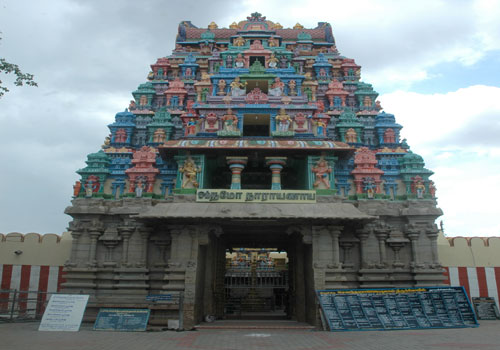Thiru Nagappattinam Soundararaja Perumal Divyadesam is very distinct and dates back across 4 Yugams. Adhisheshan, the King of Serpants had darshan in Krudha Yuga where as Bhoodevi in Thredhayuga, Markandeya Mahirishi in Dwabara Yuga andSalisugan, the Chozha King in Kali Yuga.
This is the One and Only Divyadesam where the Moolavar is blessing in his 3 Poses, inSayana Posture as Rangnathan, Sitting Posture as Govindharajan and Standing Posture as Soundararajan.
The temple main Vimanam is being worshipped as "Soundarya Vimanam" which has 5 Kalasas which is very unique and distinct and the other uniqueness is that Periya Thiruvadi Garudalwar is seen in his unusual Sitting Posture.
Thirumangai Alwar had been attracted by the beauty of ALMIGHTY as Soundara Rajan. Adhisheshan got Blessed to be the Sayanam for Ever to the ALMIGHTY only here in this Thiru Nagai Divyadesam. Hence the Place and the Temple is being called as Thiru Nagai. In Tamil Nagam means The Serpant.
Moolavar : Neelamegha Perumal, Azhagiya Perumal
Utsavar : Sowndirarajan
Thayar : Sowndaryavalli Thayar
Blessing Posture : Standing Pose Facing East Dhana Hastham
Vimanam : Sowndarya Viamanam
Puranam : Brahmanda Puranam
Pushkarini : Saara Pushkarini
Soundararajaperumal Temple is a temple dedicated to Hindu god Vishnu, located in Nagapattinam, a town in the South Indian state of Tamil Nadu. Constructed in Dravidian style of architecture, the temple is glorified in the Divya Prabandha, the early medieval Tamil canon of the Azhwar saints from the 6th - 9th centuries AD.
It is counted as one among the 108 Divya Desams dedicated to Vishnu. Vishnu is worshiped as Soundararaja Perumal and his consortLakshmi as Soundaravalli.
The temple is believed to be of significant antiquity and is believed to be initiated by the Medieval Cholas of the late 8th century AD, with later contributions at different times from Thanjavur Nayaks.
The temple has two inscriptions dating from the Chola period. The temple has a five-tiered rajagopuram (gateway tower) and enshrined within a granite wall. The complex contains all the shrines and water bodies associated with it.
Thiru Nagai Divyadesam, Ashtapuja Narasimhar is seen blessing Prahalatha in his One Hand and Abaya Hastham in the other. He performs dual duties here as Dushta Nigraham as well Sishta Paribalanam.Once Dhuruvan underwent a penance wanting to rule entire world. Pleased almighty gave him prathyaksham to him on his Garuda Vahanam.
Do:
- Do pray your Ishta Devata before pilgrimage to Temple.
- Do contact Temple Devasthanam information centre for enquiry, temple information and for Pooja details etc.
- Do reserve your travel and accommodation at Temple well in advance.
- Do bath and wear clean clothes before you enter the temple.
- Do concentrate on God and Goddess inside the temple.
- Do maintain silence and recite your Istamantram to yourself inside the temple.
- Do observe ancient custom and traditions while in Temple.
- Do respect religious sentiments at Temple.
- Do deposit your offerings in the hundi only.
Don't s:
- Do not come to Temple for any purpose other than worshipping of God and Goddess.
- Do not smoke at Temple.
- Do not consume alcoholic drinks at Temple.
- Do not eat non-vegetarian food in the Kshetram.
- Do not approach mediators for quick Darshanam. It may cause inconvenient to others.
- Do not carry any weapon inside the temple.
- Do not wear any head guards like helmets, caps, turbans and hats inside the temple premises.
- Do not perform Sastanga Pranama inside the Sanctum Sanctorum.
- Do not take much time while performing Sparsa Darshanam to God in Garbhagriha.
- Do not buy spurious prasadams from street vendors.
- Do not encourage beggars at Temple.
- Do not spit or create nuisance in the premises of the temple.
